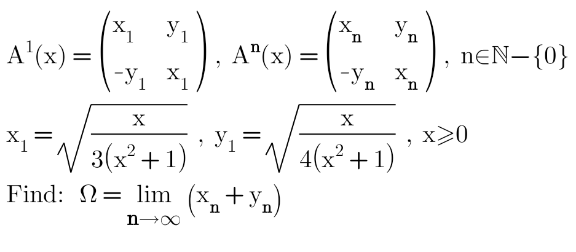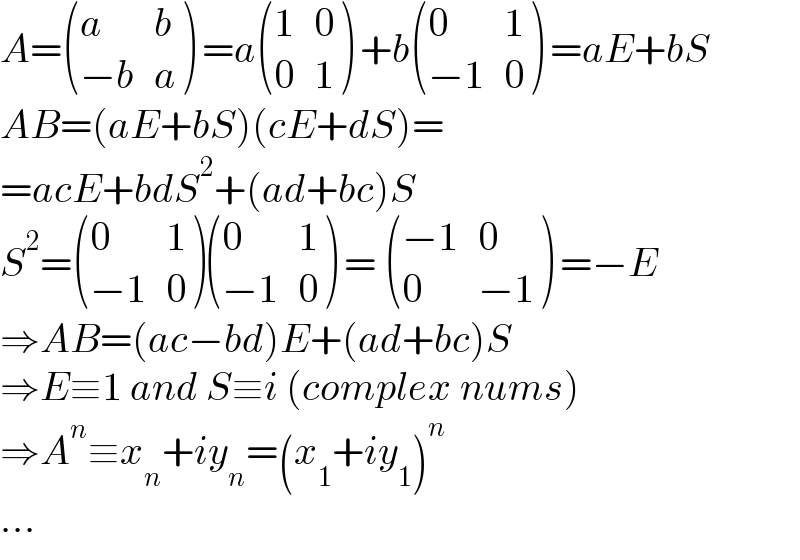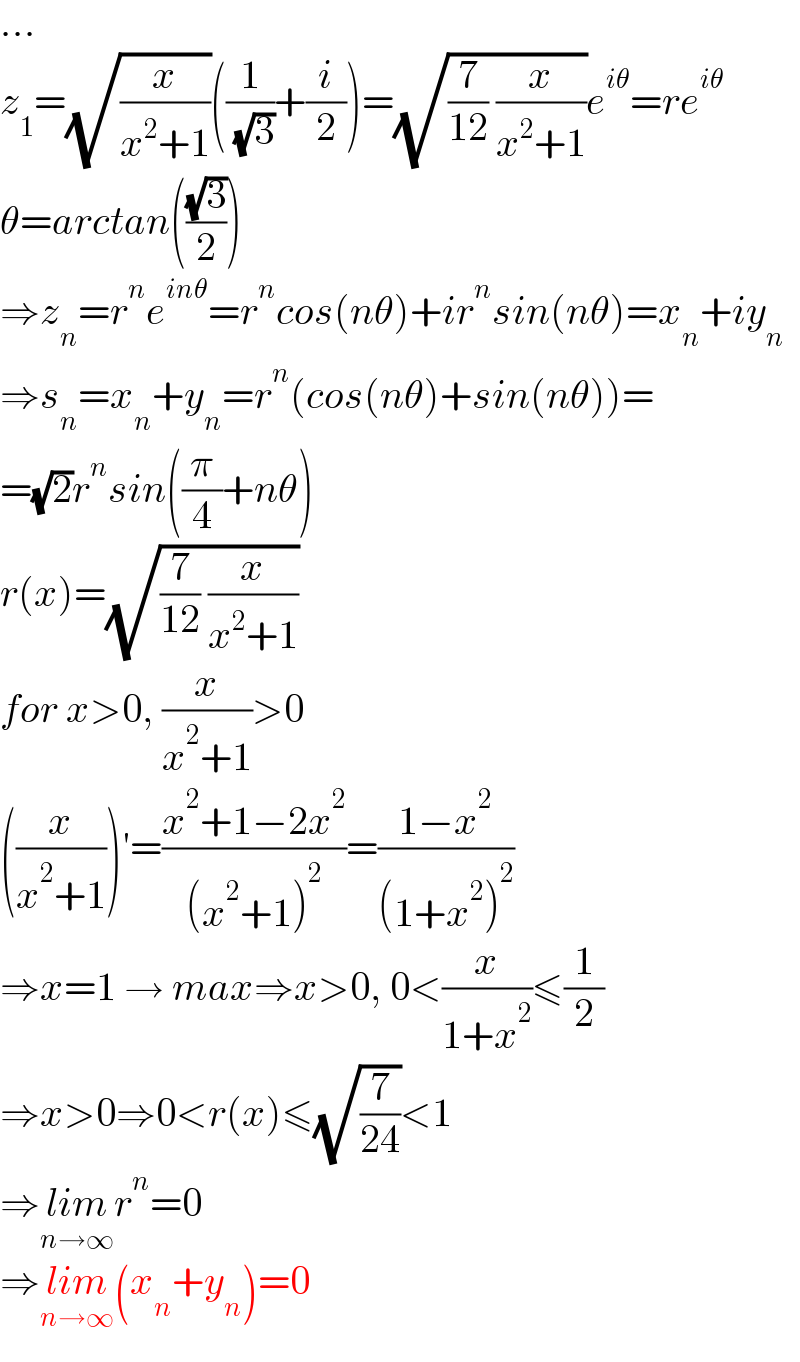Question Number 180653 by Shrinava last updated on 14/Nov/22

Answered by aleks041103 last updated on 17/Nov/22

$${A}=\begin{pmatrix}{{a}}&{{b}}\\{−{b}}&{{a}}\end{pmatrix}\:={a}\begin{pmatrix}{\mathrm{1}}&{\mathrm{0}}\\{\mathrm{0}}&{\mathrm{1}}\end{pmatrix}\:+{b}\begin{pmatrix}{\mathrm{0}}&{\mathrm{1}}\\{−\mathrm{1}}&{\mathrm{0}}\end{pmatrix}\:={aE}+{bS} \\ $$$${AB}=\left({aE}+{bS}\right)\left({cE}+{dS}\right)= \\ $$$$={acE}+{bdS}^{\mathrm{2}} +\left({ad}+{bc}\right){S} \\ $$$${S}^{\mathrm{2}} =\begin{pmatrix}{\mathrm{0}}&{\mathrm{1}}\\{−\mathrm{1}}&{\mathrm{0}}\end{pmatrix}\begin{pmatrix}{\mathrm{0}}&{\mathrm{1}}\\{−\mathrm{1}}&{\mathrm{0}}\end{pmatrix}\:=\:\begin{pmatrix}{−\mathrm{1}}&{\mathrm{0}}\\{\mathrm{0}}&{−\mathrm{1}}\end{pmatrix}\:=−{E} \\ $$$$\Rightarrow{AB}=\left({ac}−{bd}\right){E}+\left({ad}+{bc}\right){S} \\ $$$$\Rightarrow{E}\equiv\mathrm{1}\:{and}\:{S}\equiv{i}\:\left({complex}\:{nums}\right) \\ $$$$\Rightarrow{A}^{{n}} \equiv{x}_{{n}} +{iy}_{{n}} =\left({x}_{\mathrm{1}} +{iy}_{\mathrm{1}} \right)^{{n}} \\ $$$$… \\ $$
Answered by aleks041103 last updated on 17/Nov/22

$$… \\ $$$${z}_{\mathrm{1}} =\sqrt{\frac{{x}}{{x}^{\mathrm{2}} +\mathrm{1}}}\left(\frac{\mathrm{1}}{\:\sqrt{\mathrm{3}}}+\frac{{i}}{\mathrm{2}}\right)=\sqrt{\frac{\mathrm{7}}{\mathrm{12}}\:\frac{{x}}{{x}^{\mathrm{2}} +\mathrm{1}}}{e}^{{i}\theta} ={re}^{{i}\theta} \\ $$$$\theta={arctan}\left(\frac{\sqrt{\mathrm{3}}}{\mathrm{2}}\right) \\ $$$$\Rightarrow{z}_{{n}} ={r}^{{n}} {e}^{{in}\theta} ={r}^{{n}} {cos}\left({n}\theta\right)+{ir}^{{n}} {sin}\left({n}\theta\right)={x}_{{n}} +{iy}_{{n}} \\ $$$$\Rightarrow{s}_{{n}} ={x}_{{n}} +{y}_{{n}} ={r}^{{n}} \left({cos}\left({n}\theta\right)+{sin}\left({n}\theta\right)\right)= \\ $$$$=\sqrt{\mathrm{2}}{r}^{{n}} {sin}\left(\frac{\pi}{\mathrm{4}}+{n}\theta\right) \\ $$$${r}\left({x}\right)=\sqrt{\frac{\mathrm{7}}{\mathrm{12}}\:\frac{{x}}{{x}^{\mathrm{2}} +\mathrm{1}}} \\ $$$${for}\:{x}>\mathrm{0},\:\frac{{x}}{{x}^{\mathrm{2}} +\mathrm{1}}>\mathrm{0} \\ $$$$\left(\frac{{x}}{{x}^{\mathrm{2}} +\mathrm{1}}\right)'=\frac{{x}^{\mathrm{2}} +\mathrm{1}−\mathrm{2}{x}^{\mathrm{2}} }{\left({x}^{\mathrm{2}} +\mathrm{1}\right)^{\mathrm{2}} }=\frac{\mathrm{1}−{x}^{\mathrm{2}} }{\left(\mathrm{1}+{x}^{\mathrm{2}} \right)^{\mathrm{2}} } \\ $$$$\Rightarrow{x}=\mathrm{1}\:\rightarrow\:{max}\Rightarrow{x}>\mathrm{0},\:\mathrm{0}<\frac{{x}}{\mathrm{1}+{x}^{\mathrm{2}} }\leqslant\frac{\mathrm{1}}{\mathrm{2}} \\ $$$$\Rightarrow{x}>\mathrm{0}\Rightarrow\mathrm{0}<{r}\left({x}\right)\leqslant\sqrt{\frac{\mathrm{7}}{\mathrm{24}}}<\mathrm{1} \\ $$$$\Rightarrow\underset{{n}\rightarrow\infty} {{lim}r}^{{n}} =\mathrm{0} \\ $$$$\Rightarrow\underset{{n}\rightarrow\infty} {{lim}}\left({x}_{{n}} +{y}_{{n}} \right)=\mathrm{0} \\ $$
Commented by Shrinava last updated on 17/Nov/22

$$\mathrm{Thank}\:\mathrm{you}\:\mathrm{so}\:\mathrm{much}\:\mathrm{dear}\:\mathrm{professor},\:\mathrm{perfect} \\ $$
